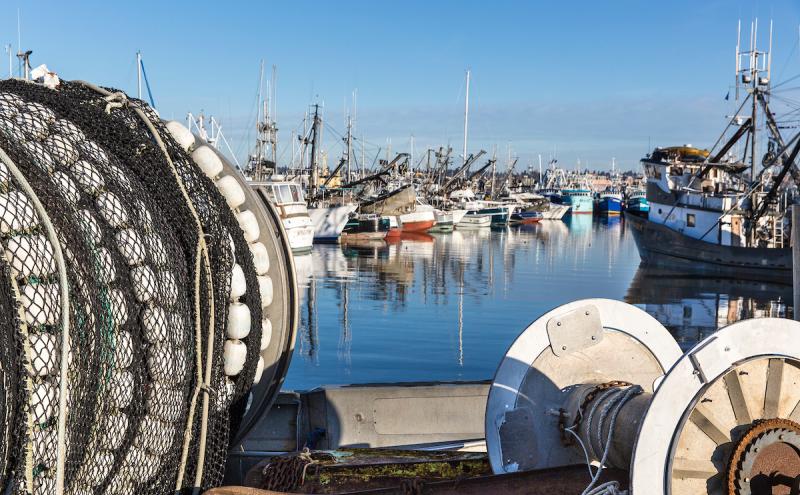With revenues up 3 percent in January and February of 2020, the industry was looking ahead to another strong year in the global marketplace.
In March, when restaurants across the country shuttered quickly under covid-19 outbreak restrictions, seafood supply chains ground to a halt in the early days of the pandemic. Fishermen who had been out harvesting to supply the once-solid market were stuck with their catch left unsold and their boats tied up.
In early March, New Jersey fisherman Gus Lovgren was headed to port after a Virginia summer flounder trip when his wife called him, “saying they’re shutting the country down, basically,” he recalled.
“We had been getting $1.75 to $2 (per pound). In the end we got, I think, 60 cents,” said Lovgren. “The market was flooded, and there was nothing we could do.”
After being up in the first two months of the year, revenues declined 19 percent in March with the first wave of shutdowns affecting primary markets nationwide. NMFS reported in January 2021 that the U.S. fishing industry lost nearly a third of its revenue in the first part of 2020, including a 45 percent loss in the month of July.
“Over those seven months we’re looking at a 29 percent decrease,” said Paul Doremus, acting administrator for NMFS.
While the report only documents revenues through July, the agency’s goal is to continue monitoring economic impacts and fishermen’s response, drawing lessons and strategies for making fishing communities more resilient.
The biggest blow early was restaurant and foodservice shutdowns, which normally account for 70 percent of purchases for the industry’s $200 billion annual revenue. Some fisheries that supply shelf-stable product lines, such as surf clams, felt less impact, but fresh markets dried up across the board.
Among shellfish growers, 74 percent reported significant losses — even with limited respite when outdoor dining was allowed in summer months.
“Harvesting, processing and distribution have been curtailed for many products and in some cases have ceased in response to restaurant and other closings throughout the country and globally,” the authors summarized.
“However, those interviewed indicated that in contrast to the fresh fish market, consumers dramatically increased supermarket purchases in late March 2020 of shelf-stable and frozen product forms,” the agency reported.
“Some industry participants are shifting from supplying restaurants to expanding sales to supermarkets and to online or direct-to-consumer sales. But the extent and volume of the pivot from restaurants to supermarket and direct-to-consumer sales has yet to be estimated.”
McKinley Research reported at the Alaska Seafood Marketing Institute’s annual meeting that domestic consumer spending on food was down across the board with an increase of 10.4 percent at grocery stores, but a 29.1 percent drop in restaurants and hotels.
The seafood sector had the biggest spike of spending at retail with a 28 percent boost. However, with increased costs and risks of operating during the pandemic, many fishing fleets felt the pinch of the crisis firsthand.
In Alaska alone, processors spent an additional $50 million to $60 million in operating costs for the 2020 fishing season, according to McKinley Research.
Leading with locals
Despite significant market losses and unmeasurable uncertainty, fishermen dove into the busy spring and summer seasons, delivering fresh and local fish to exploding rosters of local buyers, as well as food banks, across the country.
Early last year, in the San Francisco Bay area, Adam Sewall, 38, and Eleza Jaeger, 33, watched as the spread of covid-19 began to disrupt commerce and lives around the globe.
In March, their nonessential charter business and the kids’ school got shut down, so they moved the whole operation onto their boat the Gatherer and made a go of it — commercial fishing and homeschooling with the whole family onboard the 28-footer.
Jaeger and Sewall teamed up with a local community supported fishery — Sea Forager Seafood — to sell their catch, and they began documenting their lives as the School of Fish on social media.
For similar reasons, the owners of Get Hooked in Santa Barbara, Calif., jumped into local home delivery. Chief Operations Manager Victoria Voss said the company had a major uptick in subscriptions and special order requests.
“A lot of folks are subscribing and taking advantage of other delivery options to avoid going out in public,” said Voss, while others are stocking up with multiple orders.
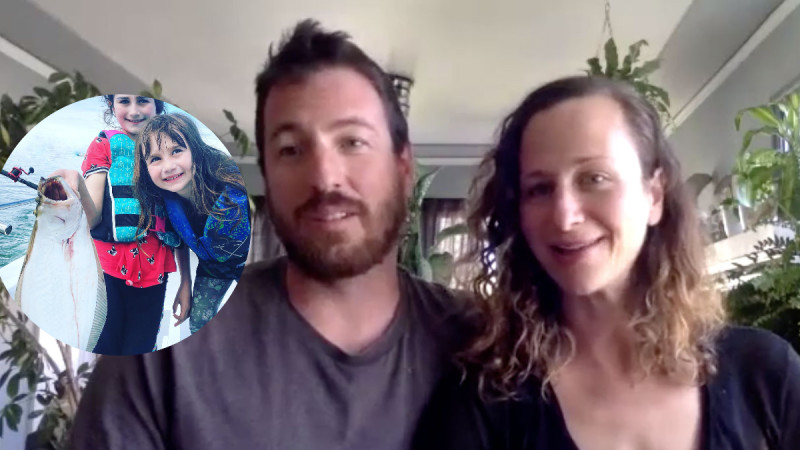
“People don’t want to be around each other right now, but they’ve got to eat,” said fishermen Craig Jacobs of O.C. Wild Seafood in Huntington Beach, Calif.
Heading up the coast to Bellingham, Wash., the Alaska fishing crew of the F/V Nerka and two partner boats sell their collective catch under Nerka Sea Frozen Salmon.
“We’re adapting on the fly and without a road map,” said Tele Aadsen, who runs the business with her husband, Joel Brady-Power.
Nerka Sea Frozen Salmon was founded by Brady-Power’s father in 1998, when he would truck his silver salmon around to local restaurants to convince them to serve his catch. Those same businesses were still taking fish from Nerka Sea until mid-March. Closures forced them to shift quickly toward selling to individuals to keep income flowing. However, selling whole, headed and gutted fish to single consumers is a bit different than selling portioned fillets.
“We’ve been lucky that folks have been so supportive. Whole fish can be intimidating or too much for consumers, but people are saying, ‘Oh no, it’s OK. We’ll take a fish and figure it out. We can look up a YouTube tutorial,’” said Aadsen.
At the Fishermen’s Dock Cooperative in Point Pleasant Beach, N.J., the fishermen regrouped going into April.
“We knew right off the kind of hit we were going to take,” said Lovgren. “We had a pop-up market that sold right off the boats, so that helped us a little.” To adjust for depressed demand and avoid flooding the New York market even more, “we all came to the conclusion to stagger our landings.”
“We fished as hard as we could just to make ends meet.”
Now, said Lovgren, “we’re getting by.” But the markets are still very fragile.
“It was starting to come back three weeks ago,” he said in late February. “We’re seeing the worst prices we have right now.”
The Yankee Fishermen’s Co-op in Seabrook, N.H., was bustling last spring and summer after shifting to local retail sales.
“Probably 90 percent of our volume went to large wholesalers, went to Boston, New York, Montreal, Toronto,” said groundfish captain David Goethel, a longtime member of the co-op.
“We’re lucky at the co-op in that we have a fish market, and the public has responded in an amazing way. And we’re selling just about everything we catch right through the market because people have realized the value of a short supply chain. They see my boat unloading, and they see the fish come through the door a few minutes later, and they know it’s only been handled by two people.”
For leaders in seafood direct marketing and community-supported fisheries, the breakdown of the U.S. seafood supply chain under the stress of the covid-19 restrictions is an example of a larger problem with our food system, not a one-time, emergency-fueled issue.
“This time of hardship has been an important reminder that the people providing our food as well as local and regional supply chains are essential,” said Brett Tolley, a community organizer with the Northwest Atlantic Marine Alliance.
“This covid-19 outbreak and the conversations about it really speak to the vulnerability of our food system,” said Joshua Stoll, a professor of Ecology and Environmental Sciences at the University of Maine and coordinator of the Local Catch Network, which supports community supported fisheries. “Almost overnight food systems came crashing down and have left fishermen, their families and coastal communities economically vulnerable. Every time an event like this occurs, we’re all in the same boat, since we have to work within a global seafood system that doesn’t really support local communities.”
Seafood donations
Feeding people well has been a consistent call to action in fishing communities, but the call was louder this year — including taking care of those who couldn’t afford to buy fish. SeaShare Executive Director Jim Harmon reported in August 2020 that volumes of donations had far exceeded prior years.
“So far this year we’ve distributed over 5 million seafood servings to food banks in 18 states,” Harmon told SeafoodSource. “That is double the volume we typically distribute January through July. Protein is the hardest item for food banks to access, and the first to run out.”
Demand, he added, is up by roughly 40 percent.
“One in six Americans are now food insecure, many of them for the first time. And if schools can’t reopen, local food banks will work to ensure that children are fed,” Harmon said.
Right out of the gates in April 2020, the Hawaii Longline Association worked with others in Hawaii’s fishing industry to donate 2,000 pounds of fresh seafood to Hawaii Foodbank, and planning larger deliveries.
The initial donation, coordinated with the with United Fishing Agency’s Honolulu auction, the Hawaii Seafood Council, Nico’s Pier 38, and Pacific Ocean Producers, “is the beginning of a new pilot program with the Hawaii Foodbank,” the association said.
“Through the partnership, Hawaii Foodbank plans to purchase $50,000 worth of seafood landed by Hawaii longline vessels,” according to a statement from the association. “The purchase will ensure that Hawaii Foodbank will be able to meet the needs of Hawaii residents facing hardship as a result of covid-19. It will also support Hawaii’s longline fishermen.”
Fish caught by longline association members, including ahi, marlin, and opah, will be distributed through Hawaii Foodbank’s network of partner agencies through distribution sites across Oahu. United Fishing Agency will break down the fish into fillets and package into insulated boxes for distribution.
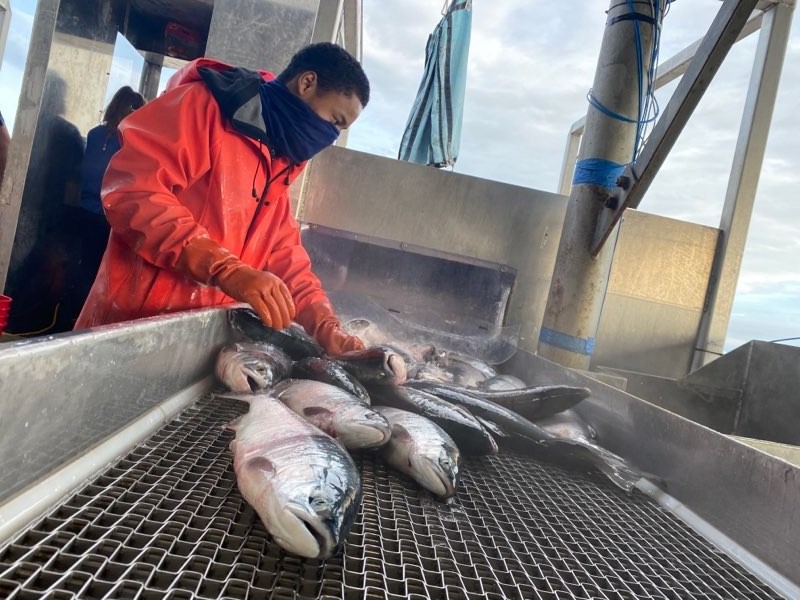
“We’re pleased to partner with Hawaii Foodbank on this important initiative supplying high-quality fresh fish to community members in need,” said Eric Kingma, executive director of the Hawaii Longline Association. “The face of hunger is changing every day, and our nearly 140 vessels operating out of Honolulu Harbor are ready and able to make critical contributions to Hawaii’s fragile food supply.”
The Hawaii longline fishery lands around 30 million pounds of fish per year, and generates more than $100 million in dockside value, placing Honolulu sixth in the nation in fisheries port value, according to NMFS statistics.
In August, two community supported fisheries announced a plan to give back to Alaska communities in need. Alaskans Own and Northline Seafoods delivered 45,000 pounds of Bristol Bay sockeye salmon to Alaska Native villages experiencing record-low returns this year.
Based in Sitka, Alaskans Own and Northline Seafoods evolved from a devotion to sustaining fishing communities.
“Northline Seafoods purchases and processes our salmon in Bristol Bay, where we’re incredibly lucky to be experiencing record-high salmon returns,” said Ben Blakey, founder and president of Northline Seafoods. “Very few sockeye salmon returned to Chignik this summer, so when we got a call requesting some of our Bristol Bay sockeye, I said we could help. We are all happy to know our catch here in Bristol Bay will fill some freezers and smokehouses, and help ensure folks in Chignik can still practice their subsistence traditions.”
The donations align with the dual focus of Alaska fishing families to sustain both coastal communities and the salmon fisheries they rely on.
“Giving up our subsistence harvest and in turn allowing the fish to escape to the river system was the right thing to do, but left local people without the salmon they depend on,” said George Anderson, president of Chignik Intertribal Coalition.
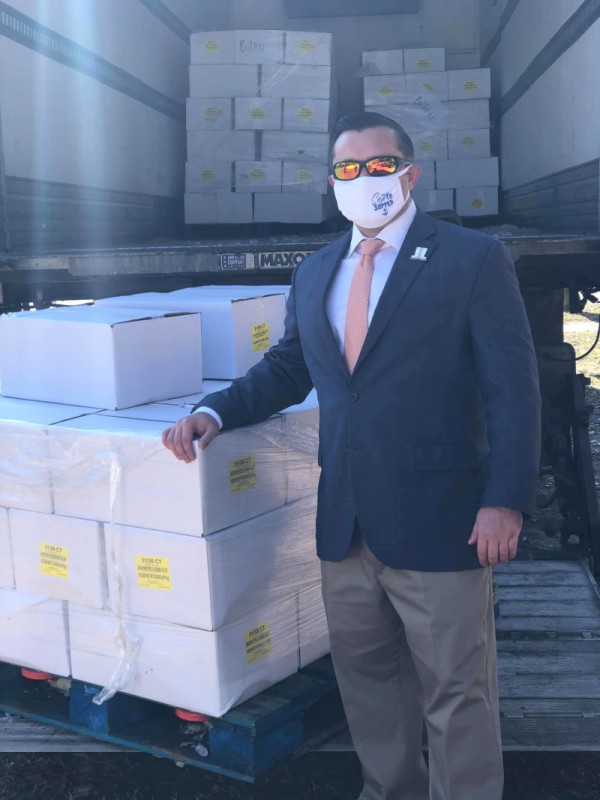
The partnership, made possible by Catch Together, allows Alaskans Own to purchase and deliver Bristol Bay salmon to the Chignik Bay and nearby communities with the potential to expand to other Alaska communities in need. Alaskans Own runs a regular Seafood Donation Program that feeds food-insecure families in Sitka.
On the Gulf Coast, a $50,000 Catch Together grant facilitated by the nonprofit Extra Table helped Mississippi Commercial Fisheries United purchase 20,000 pounds of local heads-on shrimp for donation into local food pantries.
The fishing organization coordinated with processors to have the catch processed and peeled, resulting in 13,000 pounds delivered to families in need across the state in 2-pound frozen bags, comprising 36,000 meals.
“It was a wonderful opportunity, and it was a great feeling,” said Ryan Bradley, executive director of Mississippi Commercial Fisheries United. “I got to tag along when Extra Table was distributing those shrimp. It’s not every day they get fresh seafood in these local food banks.”
Mississippi food banks are reporting a 30 to 50 percent increase in need as a result of pandemic-related hardships. The dramatic shift in market demand has affected fishermen, as well.
“With demand from restaurants all but gone, this year has been a challenge,” said Bradley. “This effort not only supports these local fishermen and their families during a difficult time, but also lets them support their fellow Mississippians with fresh, nutritious food.”
Other initiatives
In New Jersey, a grant paid local oystermen for oversized oysters they couldn’t land this year in part as an experiment in oyster production for future years.
A project led by Rutgers University and New Jersey Sea Grant bought 76,000 oysters from growers for transplant on Delaware beds and Atlantic coast oyster restoration sites in Little Egg Harbor and the Mullica River.
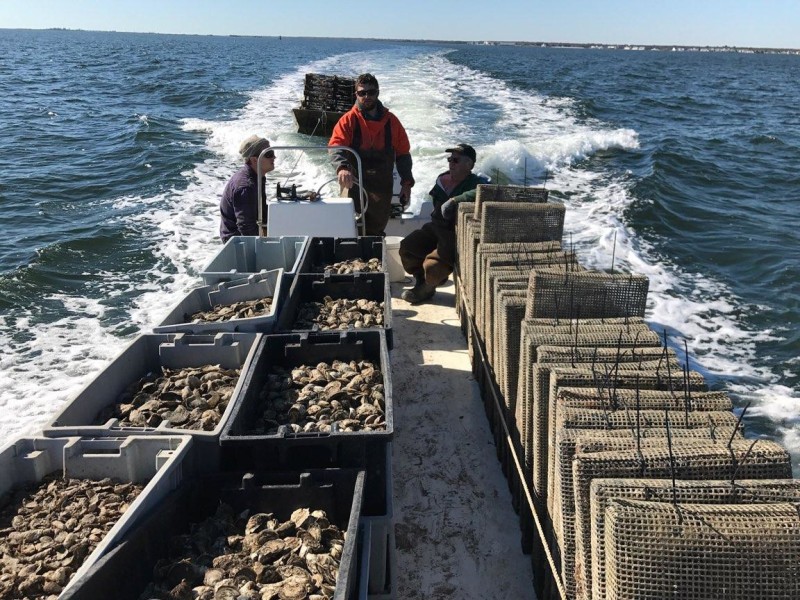
A $70,000 grant to the Haskins lab from the NOAA Sea Grant Covid-19 Rapid Response Aquaculture Funding Opportunity funded the project, which wrapped in October. Most of the money went to growers at $0.65 per oyster.
Moving those older oysters should increase the biomass and oyster larvae in the water — and could serve as a demonstration of how to bring more commercial oyster growers into ecosystem restoration programs.
“These older oysters are at an ideal reproductive age,” said Lisa Calvo, a marine scientist and aquaculture program coordinator at Rutgers University — New Brunswick’s Haskin Shellfish Research Laboratory and New Jersey Sea Grant.
The idea has been kicking around the aquaculture and coastal science community for some time, said Calvo, who hopes the transplanting “will serve as a model for future efforts and establish a shellfish exchange that will serve as a broker, linking shellfish farmers and restoration practitioners.”
The newly formed Seafood4Health Action Coalition of more than 46 organizations (full list available at eatseafoodamerica.com), convened by the Seafood Nutrition Partnership created a consumer outreach program called Eat Seafood, America! The program is aimed at helping Americans stay healthy, boosting the U.S. seafood economy, and supporting the industry’s 2 million domestic workers.
The initiative launched in April 2020 and appears to have been successful in encouraging consumers to eat more seafood. Consumers surveyed in June and July were three times more likely to have increased their seafood consumption after seeing the campaign’s messaging.
Relief aid
The U.S. Department of Agriculture’s Seafood Trade Relief Program offered a narrow bright spot with a Jan. 15, 2021, deadline for fishermen to apply for a portion of the $530 million package to help compensate for an estimated $250 million in losses in trade wars with China and the European Union.
Complications in fishing businesses’ ability to a qualify for emergency loans under the Paycheck Protection Program passed under the CARES Act in March 2020 left many shut out of the first round of loans and waiting for distribution of the $300 million in aid set aside for the fishing industry under the relief bill and second round of loans, which opened in early 2021.
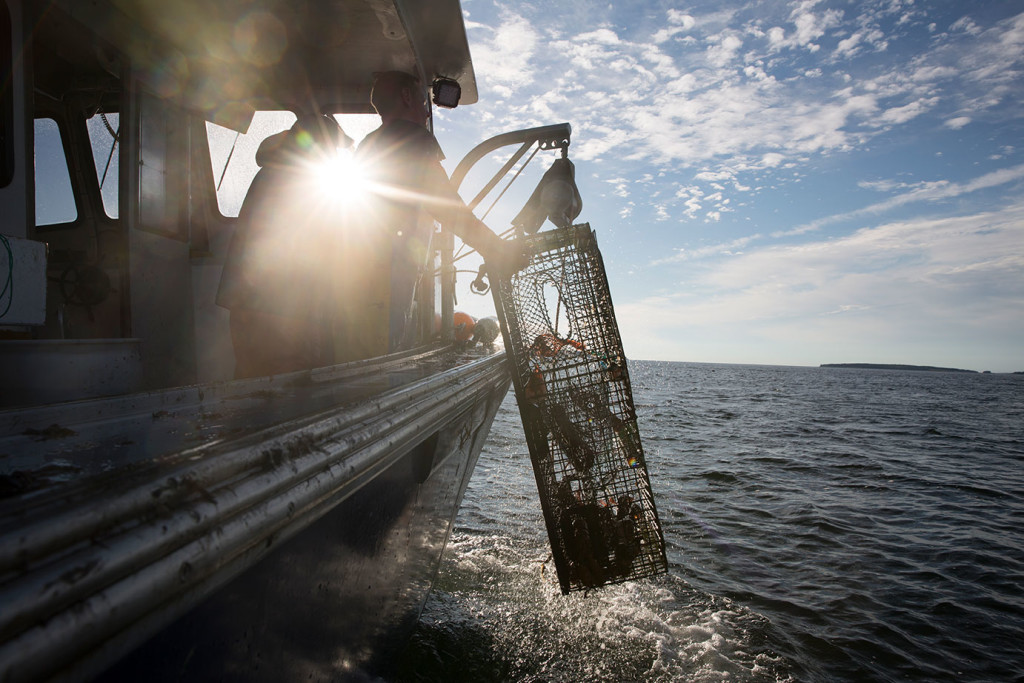
After the Department of Commerce announced its allocations for distributing fisheries-specific CARES Act aid through the states, coming up with state-by-state plans lagged well into the fall. As the year drew to a close, a third of those funds remained for delivery as states labored to complete distributions.
In Alaska there was protracted debate over how to allocate the aid among the state’s vibrant and varied fisheries.
“We agree that there is not enough funding to make each business whole,” the United Fishermen of Alaska wrote in an Oct. 22 letter urging the state Department of Fish and Game to extend public comments on the then-draft plans.
The Northeast groundfish sector was already disadvantaged in the application process by its longer-term problems before the pandemic, noted Jackie Odell, executive director of the Northeast Seafood Coalition in Gloucester, Mass.
“Groundfish was greatly impacted by loss of markets and restaurant closures, but the fishery was already in a reduced landings due to significant regulations,” said Odell. “So, the 35 percent loss over the five-year average — during that short window — was a bar that many of our members fell slightly under so did not qualify for assistance.”
Other aid efforts, including the Paycheck Protection Program, were “a boost during a very difficult time,” she said.
Maine’s allocation of $20.1 million was sending checks out to as many as 2,700 fishermen, aquaculture producers, seafood dealers and processors, and charter boat operators for delivery by Jan. 1.
Maine’s Department of Marine Resources was able to set aside $1 million of the CARES Act funds to launch a Maine Seafood brand to promote all of the state’s commercial species to a growing domestic market.
“It’s a domestic campaign,” said Jeff Nichols, director of communications for the department. “Initially we’re focused on the Northeast. That’s based on information we got from dealers and research we’ve done to identify where Maine seafood is being distributed and is available.”
The department is hoping this project will help expand markets across the state’s industry, including stakeholders who were not eligible for relief but who were still affected by market shutdowns.
“We’re working with dealers at this point,” said Nichols. “We’re going to be doing some storytelling about the industry for consumers going forward.”
Storytelling has long been a touchstone for fishing communities to connect with customers.
The industry’s ability to survive the catastrophic market collapse of 2020 speaks to the flexibility and ingenuity of our nation’s commercial fishing fleets. But unity in the face of adversity was what kept so many fishermen fishing throughout 2020 and into this year.
“There is a powerful underlying bond that exists at all times in fishing communities,” said Dock to Dish Cofounder Sean Barrett.
“That’s what has enabled this industry to survive hardship after hardship after hardship over many decades. At times like these, you can see it and feel it more than ever as everyone prepares for more hardship to come. It lets each other know that there may be many different boats, but we’re all part of the same fleet.”
Contributing Reporters: Kirk Moore, National Fisherman associate editor; and Samuel Hill, freelance journalist based in Portland, Ore.





